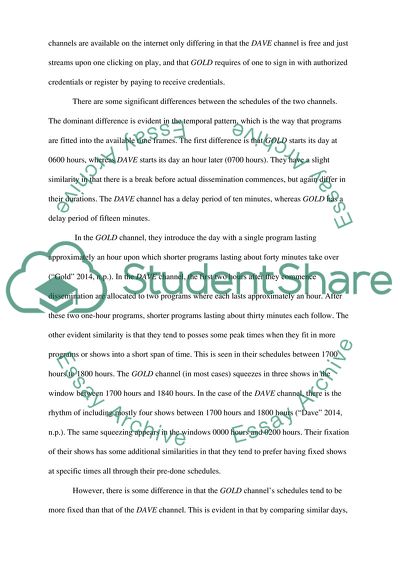Cite this document
(Television Casting Schedules Essay Example | Topics and Well Written Essays - 1250 words, n.d.)
Television Casting Schedules Essay Example | Topics and Well Written Essays - 1250 words. https://studentshare.org/visual-arts-film-studies/1823696-select-two-tv-channels-one-a-broadcaster-and-one-a-narrowcaster-and-analyse-their-schedules-how-does-each-schedule-reflect-the-perceived-temporal-rhythms-of-its-perceived-or-target-audience-please-relate-this-to-uk-tv-only
Television Casting Schedules Essay Example | Topics and Well Written Essays - 1250 words. https://studentshare.org/visual-arts-film-studies/1823696-select-two-tv-channels-one-a-broadcaster-and-one-a-narrowcaster-and-analyse-their-schedules-how-does-each-schedule-reflect-the-perceived-temporal-rhythms-of-its-perceived-or-target-audience-please-relate-this-to-uk-tv-only
(Television Casting Schedules Essay Example | Topics and Well Written Essays - 1250 Words)
Television Casting Schedules Essay Example | Topics and Well Written Essays - 1250 Words. https://studentshare.org/visual-arts-film-studies/1823696-select-two-tv-channels-one-a-broadcaster-and-one-a-narrowcaster-and-analyse-their-schedules-how-does-each-schedule-reflect-the-perceived-temporal-rhythms-of-its-perceived-or-target-audience-please-relate-this-to-uk-tv-only.
Television Casting Schedules Essay Example | Topics and Well Written Essays - 1250 Words. https://studentshare.org/visual-arts-film-studies/1823696-select-two-tv-channels-one-a-broadcaster-and-one-a-narrowcaster-and-analyse-their-schedules-how-does-each-schedule-reflect-the-perceived-temporal-rhythms-of-its-perceived-or-target-audience-please-relate-this-to-uk-tv-only.
“Television Casting Schedules Essay Example | Topics and Well Written Essays - 1250 Words”. https://studentshare.org/visual-arts-film-studies/1823696-select-two-tv-channels-one-a-broadcaster-and-one-a-narrowcaster-and-analyse-their-schedules-how-does-each-schedule-reflect-the-perceived-temporal-rhythms-of-its-perceived-or-target-audience-please-relate-this-to-uk-tv-only.


